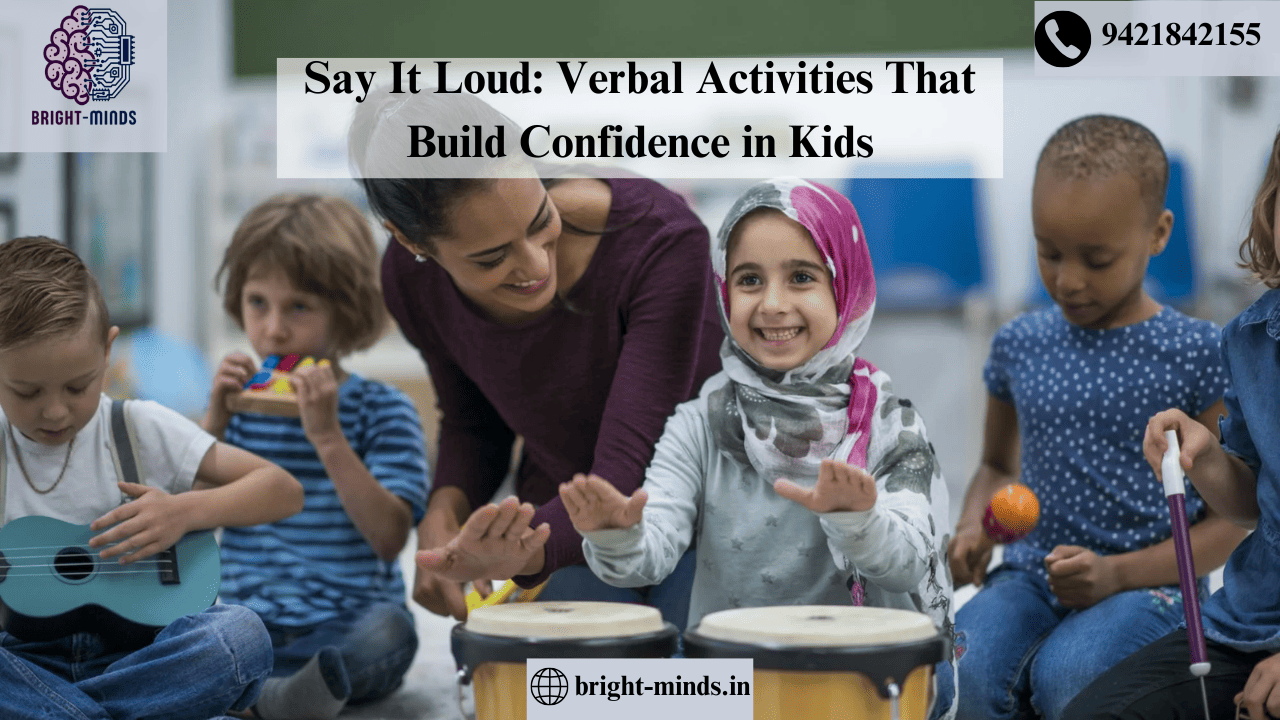Confidence is a vital skill that helps children succeed in various aspects of life, from school to relationships to personal growth. One of the most effective ways to build confidence in kids is by encouraging them to express themselves verbally. When children feel comfortable speaking up and sharing their thoughts, they develop a strong sense of self-worth and the ability to communicate clearly. Verbal activities can play a key role in helping kids find their voice and become more confident speakers.
In this blog, we’ll explore several fun and simple verbal activities that can help build confidence in kids. These activities not only promote speech and language development but also create a safe and encouraging environment where children can express themselves freely.

Why Verbal Communication Matters for Confidence
Effective verbal communication is one of the primary ways children interact with the world. Whether they’re speaking in class, playing with friends, or expressing their feelings at home, being able to communicate confidently is essential for their overall development.
When kids practice speaking confidently, they feel empowered to share their ideas, opinions, and emotions. This sense of empowerment can help them in many areas of life, from academics to social interactions. Confidence in verbal communication also teaches kids how to assert themselves respectfully and effectively, which is an important skill as they grow.
Here are some fun verbal activities that can help children develop this crucial skill:
1. Storytelling Adventures
Storytelling is a powerful tool for helping children build confidence. It encourages them to think creatively, organize their thoughts, and speak clearly. Plus, it provides a fun way for kids to practice expressing emotions and sharing ideas.
How to Play:
- Start by asking the child to tell a story, either real or imaginary. You can give them a prompt to get started, such as, “Tell me about your last adventure” or “Imagine you’re a superhero, what would you do?”
- Encourage them to use their imagination and describe characters, settings, and events in detail.
- If they struggle to come up with a story, you can help by asking questions like, “What happened next?” or “How did the character feel?”
- As they get more comfortable, let them tell longer and more detailed stories. You can even act out the story together for extra fun.
Benefits:
- Boosts creativity and imagination.
- Helps children organize their thoughts and speak clearly.
- Builds confidence in speaking in front of others, especially when they share stories with family or friends.
2. Compliment Circle
The Compliment Circle is a wonderful activity that helps kids practice speaking positively about others while also learning how to accept compliments themselves. When kids give and receive compliments, they build self-esteem and social confidence.
How to Play:
- Gather a group of children in a circle.
- Ask each child to think of a compliment for the person sitting next to them. It could be about something they like or admire about them, such as “You’re really kind” or “You always help others.”
- The child who receives the compliment must thank the giver and then give a compliment to the next person in the circle.
- Continue the activity until everyone has both given and received a compliment.
Benefits:
- Helps children learn how to give and accept compliments gracefully.
- Promotes positive self-image and boosts confidence.
- Encourages kindness and appreciation for others.
3. Show and Tell
Show and Tell is a classic activity that allows children to practice public speaking in a low-pressure setting. By sharing something they care about, children gain confidence in their ability to speak in front of others and express their thoughts.
How to Play:
- Ask each child to bring an item from home that they would like to talk about. It could be a toy, a book, a photo, or anything meaningful to them.
- When it’s their turn, the child stands up and shares their item with the group. They can describe what it is, why it’s important to them, and any interesting facts about it.
- Encourage them to speak clearly and confidently, reminding them that everyone is interested in hearing what they have to say.
Benefits:
- Builds confidence in speaking in front of a group.
- Helps children organize their thoughts and express themselves clearly.
- Provides a sense of accomplishment when they share something personal with others.
4. Debate Club for Kids
Debating is an excellent way for children to practice presenting their ideas logically and clearly. While formal debates may be too advanced for younger children, a simple version can be a great way to build confidence in expressing opinions and defending their views.
How to Play:
- Choose a fun, lighthearted topic for the debate, such as “Should pets be allowed in school?” or “Which is better: summer or winter?”
- Split the group into two teams, with each team arguing for or against the topic.
- Each team takes turns presenting their arguments, using facts or personal experiences to support their position.
- After both teams have spoken, open the floor for a brief discussion or voting on the winner.
Benefits:
- Encourages children to think critically and express their opinions clearly.
- Helps kids learn how to defend their ideas in a respectful and confident manner.
- Teaches the value of listening to others and considering different perspectives.
5. Impromptu Speaking Challenges
Impromptu speaking challenges are quick and fun activities that help kids think on their feet and speak confidently in spontaneous situations. These challenges build their ability to speak about a wide range of topics without preparation.
How to Play:
- Write down a variety of topics on slips of paper, such as “My favorite animal,” “Why I love summer,” or “What I want to be when I grow up.”
- Have the child randomly pick a slip of paper and then speak about the topic for one to two minutes without any prior preparation.
- If the child struggles, offer encouragement and remind them that the goal is simply to speak confidently and express their thoughts.
Benefits:
- Helps children become comfortable with speaking in spontaneous situations.
- Improves their ability to organize their thoughts quickly and clearly.
- Builds confidence in thinking and speaking under pressure.
6. Tongue Twister Fun
Tongue twisters are a fun and challenging way to improve verbal articulation and clarity. They help kids practice enunciating words and speaking clearly, all while having a good time.
How to Play:
- Choose a few simple tongue twisters that are age-appropriate, such as:
- “Peter Piper picked a peck of pickled peppers.”
- “She sells seashells by the seashore.”
- Have the children take turns saying the tongue twisters aloud, starting slowly and gradually increasing speed.
- Encourage them to focus on pronunciation and clarity, even if they make mistakes—it’s all about having fun and improving.
Benefits:
- Helps children improve their speech and enunciation.
- Encourages confidence in speaking clearly and at a faster pace.
- Provides laughter and fun, making verbal practice more enjoyable.
7. Role-Playing and Pretend Play
Role-playing and pretend play are excellent ways for children to practice verbal communication in various social scenarios. By acting out different roles, they can explore new vocabulary, practice dialogues, and build social confidence.
How to Play:
- Set up a pretend scenario where children can take on different roles. For example, they could play the roles of a teacher and student, a doctor and patient, or a shopkeeper and customer.
- Provide props or costumes to enhance the pretend play experience.
- Encourage kids to engage in conversations, ask questions, and respond appropriately in character.
Benefits:
- Helps children practice speaking in different social situations.
- Boosts their confidence in using language to communicate effectively.
- Stimulates imagination and creativity while building verbal skills.
8. Singing and Rhyming Games
Singing and rhyming are playful activities that help children gain confidence in speaking and listening. These activities improve speech rhythm, pronunciation, and the ability to express emotions through words.
How to Play:
- Sing simple songs or rhymes together, encouraging the children to sing along.
- You can also play a rhyming game, where one person says a word, and the others have to come up with as many rhyming words as they can.
- Try to add actions or gestures to make it more engaging and fun.
Benefits:
- Improves pronunciation, rhythm, and language comprehension.
- Encourages kids to speak and sing loudly, which builds vocal confidence.
- Provides a joyful and playful environment for practicing verbal communication.
Conclusion
Verbal activities are an excellent way to help children build confidence in their ability to express themselves. Whether it’s through storytelling, debates, or fun games like tongue twisters, these activities encourage kids to speak clearly, organize their thoughts, and interact with others in a positive and confident manner. By incorporating these activities into daily routines, you can support your child’s communication development and empower them to speak up, share their ideas, and feel confident in their own voice.
you may be interested in this blog here:-

